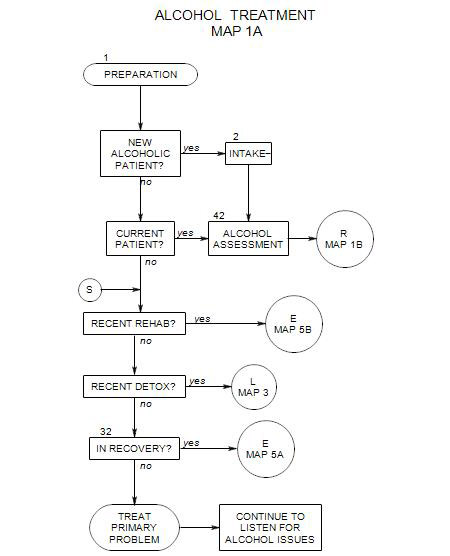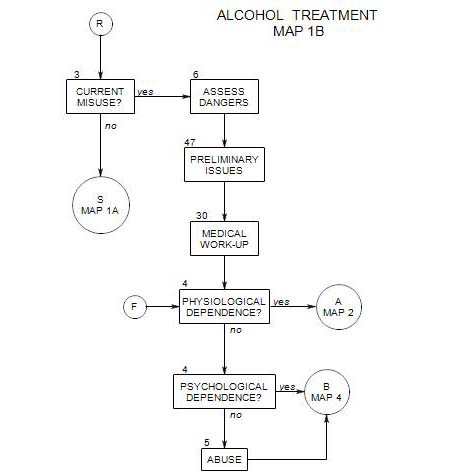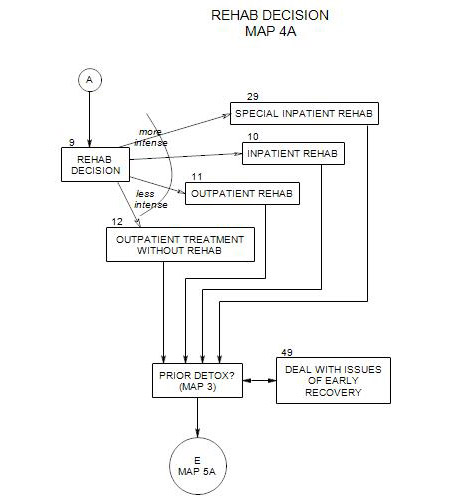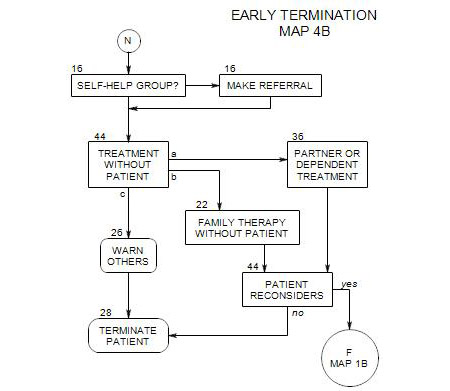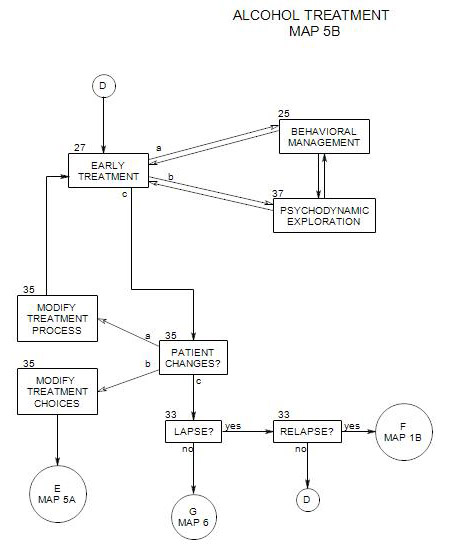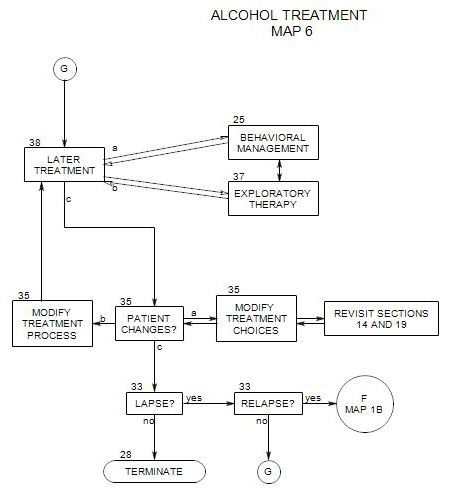16. SELF HELP GROUPS
- This section follows Section 14 [Primary Form of Outpatient Treatment] or Section 19 [Adjunctive Care Decision] on Map 4 for some patients.
There are many groups available to help people deal with the urge to drink. Some are purely local, others have national affiliations. They offer a place to meet with others that is actively oriented toward sobriety but also includes caring involvement in the lives of others. They may be sponsored by local government, religious organizations, or community service groups.
Whether they are seen as a primary form of treatment or as adjunctive care, Alcoholics Anonymous and other self-help groups provide benefits that can’t be matched in individual, couple or family therapy. Because of that, group attendance should be recommended to any patient for whom it is appropriate.
Self-help groups vary widely in their affiliations, tone and attitude and theory of recovery. Most emphasize abstinence as a primary goal. Most involve sharing experiences, techniques for not-drinking, and emotional support among group members.
A major benefit of group attendance comes from being part of a community of people who share a common purpose, who are available to one another, and who share their experiences, hopes, and wisdom with each other. In many areas, there are meetings every day and at different times throughout the day; and group members are available to one another at all times of the day and night.
16a. As the Primary Form of Treatment
Immediately following detox and/or rehab, participation in a self-help group may be the most important part of the patient’s recovery plan. For many people, it remains their primary treatment modality for an extended period of time. Its advantages as a primary form of treatment include:
- The patient can get a sense of belonging and shared purpose from the group.
- A professional setting can be avoided.
- Self help groups are typically offered without fee or with minimal cost.
- The patient may have an increased sense of being in charge of his or her own recovery.
It is not uncommon for a recovering alcoholic to think of the group as his/her primary form of treatment or to choose it as his or her only form of treatment. However, it is unusual for a therapist to think of a self-help group as primary. One exception is Nowinski [1996], who argues that not only is behavioral management the preferred form of treatment for early recovery, but also that self help groups are best suited to provide it.
Sole or primary involvement in a self-help group may be a reasonable recommendation for a person who is unwilling or unable to continue in psychotherapy. It could also be recommended indirectly to a patient’s relative or friend if that person won’t come to the therapist’s office.
At least one form of psychotherapy [Nowinski, 1996] is based on the idea that AA should be the primary form of treatment for a person in early recovery.
16b. As an Adjunctive Treatment
Participation in a self-help group can be a powerful supplement to the work of therapy in many ways, including
- immediate experiences with other recovering alcoholics.
- hearing reports of their lives and issues.
- contact with people who can serve as models and provide incentives for the patient’s own work.
- the opportunity to unburden in the presence of a group of sympathetic listeners, which can in itself be healing.
Groups can provide a counter to the feeling of being alone with one’s addiction, regular contact with peers, and around-the-clock support.
The work done in the self-help group can begin the process of behavioral management, as the patient learns techniques for self control from other group members and wants to expand on them or personalize them in individual treatment. The reports of others’ lives and histories can also stimulate recollection of the patients own experiences and history, leading to further psychodynamic exploration.
16c. The Choices
There are a variety of self-help organizations available to patients, depending on availability and the person’s specific needs. They differ with regard to overall goals and procedures. Information about them can be found on the Internet; but there is no better way to learn about particular groups than by attending their meetings. Most groups have a lot in common with Alcoholics Anonymous, and for that reason, general characteristics are discussed under the AA heading below. Some of the specific ways in which other organizations differ from AA are then listed under their individual headings. This is not an exhaustive listing but rather an indication of possibilities.
ALCOHOLICS ANONYMOUS
AA is a national and world-wide self-help organization. Each local chapter is referred to as a “group”. Attendance is free. Groups emphasize non-judgmental, empathic understanding. The goal is total abstinence, with understanding and support for participants who have difficulty attaining that goal. Often a rigorous commitment to regular attendance is necessary, to ensure sobriety.
Each group meets on a regular basis; participants are encouraged by each other to attend more frequently, as needed. Through a person’s involvement with other members, the group becomes a 24-hour, seven days-per-week resource.
There are a variety of indices of a patient’s involvement with AA, including
- regular attendance at meetings.
- finding a “home group”.
- obtaining a sponsor.
- making the “90 in 90” commitment [a meeting a day for three months].
- accepting a formal responsibility in the home group, e.g.: making coffee or arranging chairs.
AA offers the alcoholic patient many things, including availability, proven effectiveness, comprehensiveness, and cost (it’s free). For most alcoholics, AA is the program of choice in early recovery.
Some people have difficulties with AA, particularly the repetitiveness of other participants’ stories, the emphasis on a Higher Power, the disease concept of alcohol misuse, the press for total abstinence, and so on. Some of these objections can be relieved by reading AA literature or talking with other members. Many of these difficulties can profitably be treated as resistances within exploratory therapy. Patients can be encouraged to take what they need and not be offended by the rest. Or they can be sent to different AA meetings [each meeting has its own character and membership] or to other self help groups.
Some women have difficulty in AA, where an emphasis on surrender, powerlessness, and control of anger may be counter-therapeutic for them. Also, there is a focus in AA on negative situations and acts that the alcoholic created or was involved in; whereas for many women issues of guilt and shame are so prevalent that they may benefit more from an emphasis on self-forgiveness.
AL-ANON is a self-help organization affiliated with AA and directed to the needs of people closely involved with alcoholics (usually spouses).
L-A-TEEN has groups for adolescent alcoholics or the adolescent children of alcoholic parents.
LIFE RING is open to alcoholics and people involved with alcoholics. Groups are run by peers. Each member develops his/her own recovery program. There are no sponsors, no prayers in meetings, and no reliance on a Higher Power.
MODERATION MANAGEMENT is intended for problem drinkers who are not alcohol dependent and who want to continue drinking in moderation. It treats problem drinking as a habit and not a disease, and allows members to set their own individual drinking goals. Meetings can be either face-to-face or on-line.
RATIONAL RECOVERY is a for-profit program offered via the Internet, with a goal of permanent abstinence. The focus is on control of the impulse to use alcohol or other substances, by employing effective mental skills. There are no physical groups.
SMART RECOVERY treats substance use and dependency as habit rather than disease, and provides techniques for dealing with urges to drink. Groups are run by volunteers with the help of professional advisors.
WOMEN FOR SOBRIETY is limited to women, whose needs are seen as different from those of men. All meetings are closed and run by moderators. There is no dependence on a Higher Power. Focus issues include positive thinking, improving self esteem, changing priorities, and abstinence.
Many religious and service organizations offer ACOA groups, for adult children of alcoholic parents, and co-dependency groups. ACOA groups are helpful for many alcoholics later on, but early in recovery may distract the person from a focus on personal abstinence.
Patients who are dually addicted might do well in Narcotics Anonymous.
16d. Making the Referral
Before making a referral, you should consider researching your local community for available resources, with a goal of recommending a group that is both available and compatible with the patient’s perspective. Patients have many reasons for not going, and it is a good idea to make the process as easy as possible for them.
Although some therapists require participation in AA or another self help group for patients with serious alcohol issues, such a requirement can encourage resistance in a way that is difficult to explore. It is generally more fruitful to make a strong suggestion and then explore a patient’s reaction to it. Does he/she begin to go immediately, or make excuses not to go, or forget to go? Does he/she go and appreciate the support and work of the other members, or return with criticisms of the program or the other participants? If the latter, what defensive function is his/her criticism serving?
It is common for patients to be resistant to going to the first meeting. This can be handled in a variety of ways, from facilitating attendance to exploring the issues involved in the resistance. To some extent, the choice of approach must depend on a balance between the perceived urgency in getting the patient into a self-help environment and the long term benefits of greater self-awareness.
If there is greater pressure to involve a patient in meetings, some steps can be taken to make attendance easier.
- Offering a list of meetings, with times and places, can reduce some initial anxiety due to vagueness.
- A telephone number to get further information may be helpful to some.
- A description of the meetings can relieve some sense of strangeness – especially if you have attended some meetings yourself and can describe them from personal experience.
- Some people take comfort in reassurances that meetings are anonymous, respectful, low pressure and supportive.
- Arranging for someone to accompany the patient to a first meeting can ease the anxiety of entry into an new group. Ideally this would be someone the patient already knows and suggests, but someone known to the therapist can also be a source of security and comfort in a new setting.
- Going to meetings can be offered as an experiment, for the patient to determine whether they are helpful or not.
Once a person has attended a meeting, and continuing after at least the first few meetings, his/her reactions to them can be examined as part of treatment. They can be a source of increased self awareness in many ways, including reactions to other participants, to the quality of the group, to issues raised there, to the level of support from others, to the tone of the meetings, to being labeled an alcoholic by group membership, and so on.
Resources
Nowinski discusses a particular plan, called Twelve Step Facilitation, by means of which the psychotherapy perspective can be used to help involve patients in self-help group work early in recovery.
Wallace discusses the effectiveness of self- help programs and some aspects of the programs that make them effective.
